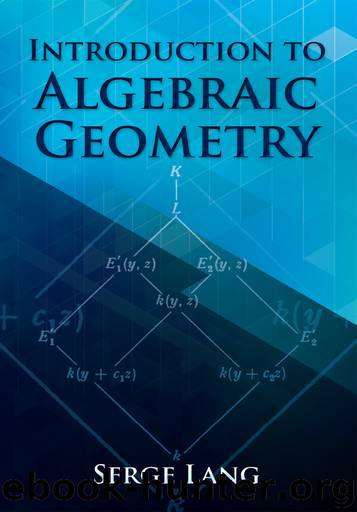Introduction to Algebraic Geometry by Serge Lang

Author:Serge Lang
Language: eng
Format: epub
Publisher: Courier Publishing
Published: 2019-03-12T16:00:00+00:00
PROPOSITION 2. Let T : U → V be a birational correspondence defined over a field k. Let (x) be a generic point of U over k, and T(x) = (y). Assume that k[x] = R is contained in k[y] = S and that k[y] is integral over k[x]. Then the set of points on U or V where T is not biholomorphic is the k-closed set of zeros of the conductor a of S over R.
Proof: Our statement depends on the fact that is an ideal of S and R, and hence determines an algebraic set both on U and V.
Let us begin with U. Let (x’) be a point of U where T is not defined. If (x’) is not a zero of the conductor, then there exists f(x) in such that f(x’) ≠ 0. By definition, for each coordinate yj of (y) we have f(x)yj = gj(x). This shows that yj = gj(x)/f(x), and that T is defined at (x’), a contradiction.
Conversely, suppose that T is defined at (x’). By the lemma, we can write S = Rw1 + . . . + Rwm, and by hypothesis Wi = fi(x)/gi(x), where gix’) ≠ 0. Hence gi(x)wi = fi(x), and by definition, we see that the product g of the gi(x) must be in the conductor. But g(x’) ≠ 0, and hence (x’) cannot be a zero of the conductor.
Let us now go over to V. Let (y’) be a point of V where T–1 is notbiholomorphic. If we put T–1(y’) = (x’), then Pcannot be defined at (x’). If (y’) is not a zero of the conductor (viewed as an ideal of k[y]) then (x’) cannot be a zero of the conductor (viewed as an ideal of k[x] and we have a contradiction as before. The converse is proved the same way.
Download
This site does not store any files on its server. We only index and link to content provided by other sites. Please contact the content providers to delete copyright contents if any and email us, we'll remove relevant links or contents immediately.
| Algebraic Geometry | Analytic Geometry |
| Differential Geometry | Non-Euclidean Geometries |
| Topology |
Modelling of Convective Heat and Mass Transfer in Rotating Flows by Igor V. Shevchuk(6404)
Weapons of Math Destruction by Cathy O'Neil(6199)
Factfulness: Ten Reasons We're Wrong About the World – and Why Things Are Better Than You Think by Hans Rosling(4709)
A Mind For Numbers: How to Excel at Math and Science (Even If You Flunked Algebra) by Barbara Oakley(3247)
Descartes' Error by Antonio Damasio(3244)
Factfulness_Ten Reasons We're Wrong About the World_and Why Things Are Better Than You Think by Hans Rosling(3216)
TCP IP by Todd Lammle(3151)
Fooled by Randomness: The Hidden Role of Chance in Life and in the Markets by Nassim Nicholas Taleb(3075)
Applied Predictive Modeling by Max Kuhn & Kjell Johnson(3037)
The Tyranny of Metrics by Jerry Z. Muller(3021)
The Book of Numbers by Peter Bentley(2925)
The Great Unknown by Marcus du Sautoy(2657)
Once Upon an Algorithm by Martin Erwig(2613)
Easy Algebra Step-by-Step by Sandra Luna McCune(2598)
Lady Luck by Kristen Ashley(2548)
Police Exams Prep 2018-2019 by Kaplan Test Prep(2512)
Practical Guide To Principal Component Methods in R (Multivariate Analysis Book 2) by Alboukadel Kassambara(2510)
All Things Reconsidered by Bill Thompson III(2367)
Linear Time-Invariant Systems, Behaviors and Modules by Ulrich Oberst & Martin Scheicher & Ingrid Scheicher(2345)
